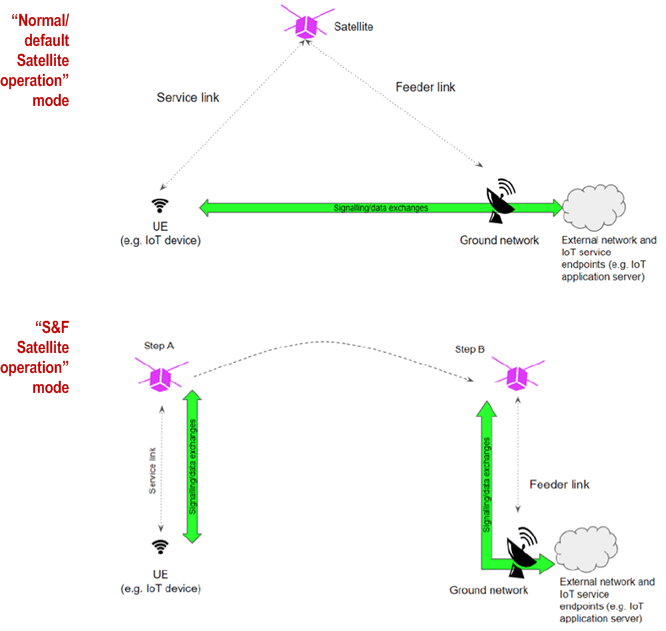Content for TR 22.865 Word version: 19.2.0
A Store and Forward Satellite operation p. 43
The Store and Forward Satellite operation in a 5G system with satellite access is intended to provide some level of communication service for UEs under satellite coverage with intermittent/temporary satellite connectivity (e.g. when the satellite is not connected via a feeder link or via ISL to the ground network) for delay-tolerant communication service.
An example of "S&F Satellite operation" is illustrated in Figure A-1, in contrast to what could be considered the current assumption for the "normal/default Satellite operation" of a 5G system with satellite access.
As shown in Figure A-1:
- Under "normal/default Satellite operation" mode, signalling and data traffic exchange between a UE with satellite access and the remote ground network requires the service and feeder links to be active simultaneously, so that, at the time that the UE interacts over the service link with the satellite, there is a continuous end-to-end connectivity path between the UE, the satellite and the ground network.
- In contrast, under "S&F Satellite operation" mode, the end-to-end exchange of signalling/data traffic is now handled as a combination of two steps not concurrent in time (Step A and B in Figure A-1). In Step A, signalling/data exchange between the UE and the satellite takes place, without the satellite being simultaneously connected to the ground network (i.e. the satellite is able to operate the service link without an active feeder link connection). In Step B, connectivity between the satellite and the ground network is established so that communication between the satellite and the ground network can take place. So, the satellite moves from being connected to the UE in step A to being connected to the ground network in step B.

Figure A-1: Illustration of "normal/default operation" and "S&F operation" modes in a 5G system with satellite access
(⇒ copy of original 3GPP image)
(⇒ copy of original 3GPP image)
The concept of "S&F" service is widely used in the fields of delay-tolerant networking and disruption-tolerant networking. In 3GPP context, a service that could be assimilated to an S&F service is SMS, for which there is no need to have an end-to-end connectivity between the end-points (e.g. an end-point can be a UE and the other an application server) but only between the end-points and the SMSC which acts as an intermediate node in charge of storing and relying.
The support of S&F Satellite operation is especially suited for the delivery of delay-tolerant/non-real-time IoT satellite services with NGSO satellites.